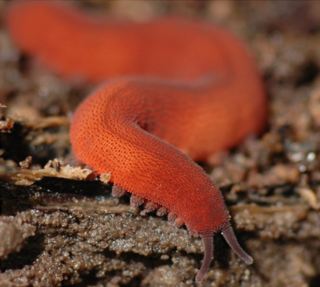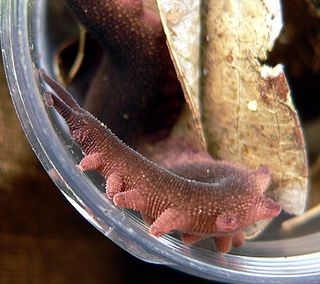
Epiperipatus is the most diverse genus of neotropical velvet worms in the family Peripatidae. Species in this genus are found in Central and South America. This genus is viviparous, with mothers supplying nourishment to their embryos through a placenta.

Oroperipatus is a genus of Neotropical velvet worms in the family Peripatidae. Species in this genus are found in South America west of the Andes and in Mexico. This genus is viviparous, with mothers supplying nourishment to their embryos through a placenta.

Eoperipatus totoro is a species of velvet worm of the family Peripatidae. This species is notable as the first velvet worm from Vietnam to be formally described. As of 2023, E. totoro remains the only species of velvet worm from Vietnam to be described.
Eoperipatus horsti is a species of velvet worm in the Peripatidae family. Authorities have designated this velvet worm as the type species for the genus Eoperipatus, because among the species originally included in this genus, this species is the only one known from descriptions of both sexes. This species is found in Malaysia.
Epiperipatus barbadensis is a species of velvet worm in the Peripatidae family, first described based on specimens from Barbados. It is one of the velvet worms that most often is kept in captivity, and was the first member of the Peripatidae family to be successfully maintained by hobbyist invertebrate keepers; it is easier to keep than the majority of other velvet worm species that have been tried, but still has specialized requirements that resemble those necessary for keeping poison dart frogs. E. barbadensis is social, nocturnal and viviparous, can live for several years, and feeds on small invertebrates that are caught by ejecting an adhesive slime from glands on their head.
Epiperipatus cratensis is a species of velvet worm in the family Peripatidae. This species is found in northeastern Brazil. This velvet worm is notable as a small species of Epiperipatus with many legs.
Epiperipatus hilkae is a species of velvet worm in the Peripatidae family. This species is found in Costa Rica. This velvet worm is closely related to another species of Epiperipatus found in Costa Rica, E. isthmicola. The species E. hilkae is named in honor of the German zoologist Hilke Ruhberg for her extensive work on velvet worms.
Oroperipatus bimbergi is a species of velvet worm in the Peripatidae family. The female of this species has 27 or 28 pairs of legs, usually 27; the male has 24 or 25 usually, rarely 26. The type locality is in Colombia.
Oroperipatus bluntschli is a species of velvet worm in the Peripatidae family. The original description of this species is based on a female specimen measuring 100 mm in length; its 40 pairs of legs are notable for approaching the maximum number (43) recorded in velvet worms. The type locality is in Peru.
Oroperipatus corradoi is a species of velvet worm in the Peripatidae family. Females of this species have 26 to 29 pairs of legs, usually 28; males have 24 to 27. Females range from 14 mm to 60 mm in length, while males range from 14 mm to 25 mm in length. The type locality is in Ecuador.

Oroperipatus eisenii is a species of velvet worm in the family Peripatidae. Females of this species have 27 to 29 pairs of legs, usually 28; males have 23 to 26. Females range from 30 mm to 57 mm in length, while males range from 20 mm to 23 mm. The type locality is found in Brazil and central Mexico.
Oroperipatus lankesteri is a species of velvet worm in the Peripatidae family. This velvet worm is notable for its large size, reaching 82 mm in length. This species is known only from its type locality in the northern Pacific lowlands of Ecuador.
Oroperipatus omeyrus is a species of velvet worm in the Peripatidae family. This species is blackish red on its dorsal surface but lighter and brownish on its ventral surface. The original description of this species is based on female specimens with 24 to 26 pairs of legs and an embryo with 22 pairs of legs. The females range from 16 mm to 22 mm in length. The type locality is in Peru.
Oroperipatus weyrauchi is a species of velvet worm in the Peripatidae family. The original description of this species is based on only two specimens, a male with 40 pairs of legs and a larger female with 38 leg pairs. The type locality is in Peru.
Peripatus dominicae is a species of velvet worm in the Peripatidae family. The type locality for this species is on the Caribbean island of Dominica. Although the Canadian zoologist Stewart Peck introduced the name Peripatus dominicae dominicae in 1975 to distinguish the original species from other subspecies then assigned to P. dominicae, authorities now deem these subspecies to be separate species in light of the significant distances between their type localities.

Peripatus juanensis is a species of velvet worm in the Peripatidae family discovered in Puerto Rico in 1900. As of 2018, it is the only velvet worm found in Puerto Rico. Females of this species have 31 or 32 pairs of legs; males have 27.
Paraperipatus keiensis is a species of velvet worm in the Peripatopsidae family. Females of this species have 24 or 25 pairs of legs; males have 22 or 23 leg pairs. The type locality is in Kai Besar in Indonesia.
Ooperipatellus nickmayeri is a species of oviparous velvet worm in the family Peripatopsidae. This species is larger than any other in the genus Ooperipatellus. With a body size exceeding 60 mm in females and 30 mm in males, these velvet worms can be more than twice as long as other species of this genus.
Epiperipatus hyperbolicus is a species of velvet worm in the family Peripatidae. This velvet worm is known only from its type locality in the state of Alagoas in Brazil. The species name refers to the unusually large apical piece on the primary papillae on this velvet worm. This distinctive apical piece is notable for its size and spherical shape. The males of this species have 23 pairs of legs; females have 24 or 25 pairs.
Epiperipatus titanicus is a species of velvet worm in the family Peripatidae. This velvet worm is known only from its type locality in the state of Alagoas in Brazil. The species name refers to the large size of its females and its numerous legs. This species features more legs than any other Brazilian species of velvet worm.




